If you’ve ever dreamed of earning money while you sleep, selling digital products online might just be the golden ticket. In today’s fast-paced digital economy, people are buying eBooks, online courses, art prints, templates, and even AI-generated tools, all without shipping or inventory.
The best part? You don’t need to be a tech genius to start. Whether you’re a freelancer, artist, content creator, or complete beginner, selling digital products is one of the most profitable and scalable online business models in 2025.
In this post, let’s dive deep into:
- Why selling digital products is trending right now
- The key metrics you must track to grow
- Step-by-step setup guide
- What tools and platforms you’ll need
- And how to sell globally to maximize your income
Why Selling Digital Products Is the Future
The last few years have changed how people learn, work, and shop. Physical goods still dominate, but digital products have exploded in popularity because of their accessibility and convenience.
Let’s look at a few reasons why this trend is here to stay:
1. Low Startup Costs
Unlike physical businesses, there’s no warehouse, packaging, or shipping. You can create and sell a product using just your laptop and internet connection.
2. No Inventory or Delivery Hassles
Once a customer buys your product, they instantly receive it via email or download. That means your business can run on autopilot.
3. Global Reach
Anyone with an internet connection can become your customer. Whether you’re in India or Indonesia, your product can reach someone in Canada or Germany within minutes.
4. Infinite Scalability
Digital products can be sold again and again without restocking. The profit margins are high because there’s no production cost per sale.
5. Automation Is Easy
From checkout to file delivery, everything can be automated using tools like WooCommerce, Gumroad, or SendOwl. Once set up, you just focus on marketing and creating new content.
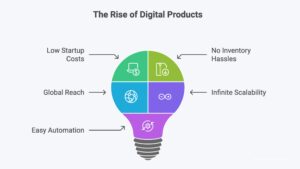
The Growing Market
The global digital product market is expected to reach $300+ billion by 2030, driven by e-learning, digital art, and software templates. Even individuals who once worked only on freelancing platforms are now turning to product creation — because one product can sell thousands of times.
Think of creators on Etsy selling digital planners, photographers offering Lightroom presets, or YouTubers launching online courses, all these are digital products, and they’re booming.
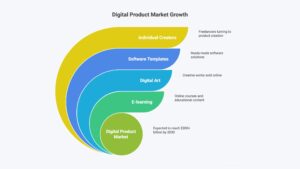
Understanding the Key Metrics
Running a digital product business is more than just uploading a file online. You need to track performance like any real business. Let’s look at the most important metrics:
1. Conversion Rate
This shows how many visitors actually buy.
A good conversion rate for digital products is 2–5%, but with better landing pages and copywriting, you can push it even higher.
2. Traffic Sources
Where are your buyers coming from? Is it social media, Google search, or email campaigns?
Use tools like Google Analytics or Plausible to track your visitors and focus your marketing accordingly.
3. Average Order Value (AOV)
If a customer buys a $20 eBook and a $30 template, their order value is $50.
Use upsells and bundles to increase your AOV.
4. Refund Rate
Keep your refund rate below 3%. High refunds may indicate unclear descriptions or low-quality products.
5. Customer Lifetime Value (CLV)
How much revenue does one buyer generate over time?
For example, if a customer buys one course and later purchases your templates, their CLV increases.
6. Email Subscribers
Your email list is your long-term asset. Even if social media platforms change algorithms, your email subscribers stay loyal.
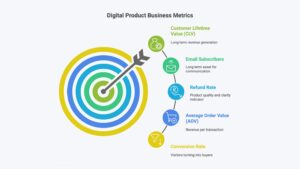
How to Set Up Your Digital Product Store
Let’s walk through a practical setup, even if you’re a beginner.
Step 1: Choose Your Niche
Pick a category you’re skilled or passionate about. Examples:
- Digital art & AI-generated prints
- eBooks or guides
- Online courses & tutorials
- Notion templates, design assets, or social media kits
- Music, sound effects, or beats
- Coding scripts or plugins
Pro Tip: Validate your niche on platforms like Etsy, Gumroad, or Creative Market by checking what sells best.
Step 2: Create a High-Quality Product
You don’t need fancy tools. Start small:
- Canva or Figma for design templates
- ChatGPT or Notion for writing eBooks and guides
- InVideo or CapCut for creating video tutorials
- Audacity or GarageBand for digital audio files
Focus on quality and usability. If your customers get value, they’ll come back for more.
Step 3: Build Your Online Store
There are many ways to sell digital products:
Option 1: WordPress + WooCommerce
Best if you want full control, SEO optimization, and branding.
You can host your digital files securely and integrate gateways like PayPal, PayU, or Stripe.
Option 2: Gumroad or Payhip
Best for beginners, no coding, simple setup, and instant global reach.
Option 3: Etsy or Creative Market
Ideal for design assets, printables, or digital art.
Step 4: Add Payment Gateways
If you’re in India, go with:
- PayU or Razorpay for domestic buyers
- PayPal or Stripe for international buyers
Always test your checkout process before going live.
Step 5: Automate Delivery
Once payment is confirmed, your customer should instantly receive the file.
WooCommerce, Gumroad, and Payhip have built-in auto-delivery systems, no manual sending needed.
You can also use:
- SendOwl for automated file delivery
- LemonSqueezy for SaaS-style digital sales
Step 6: Market Your Products
Creating your digital product is only half the job. You must now promote it effectively.
Use Content Marketing
Write blog posts or YouTube videos around your product topic. Example: If you sell Canva templates, write “How to Create a Brand Kit in Canva.”
Leverage Social Media
Show behind-the-scenes, customer reviews, or short demo videos. Platforms like Instagram, Pinterest, and TikTok work wonders for digital visuals.
Run Paid Ads
Use Facebook, Google, or Pinterest ads with small budgets to test which products attract more clicks.
Build an Email List
Offer a freebie (like a mini eBook or checklist) in exchange for emails. Then nurture leads through weekly newsletters.
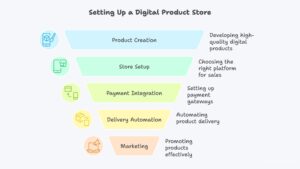
Selling Globally – The Smart Way
Once your store is ready, you can reach customers around the world. Here’s how to do it right:
1. Offer Multiple Payment Options
Include PayPal, credit/debit cards, and even crypto options if your platform supports them.
2. Use Multi-Currency Support
Let users see prices in their own currency. Platforms like Payhip, Gumroad, and WooCommerce plugins handle this easily.
3. Write Global-Friendly Product Descriptions
Avoid local slang. Use simple, universal English so international buyers can understand your offer clearly.
4. Use SEO Targeting
Optimize your listings with global search terms like “digital planner PDF,” “AI art pack,” or “online marketing course.”
5. Time-Zone Automation
Set up automatic systems for support and delivery so global buyers don’t have to wait.
Globally – The Smart Way
Once your store is ready, you can reach customers around the world. Here’s how to do it right:
1. Offer Multiple Payment Options
Include PayPal, credit/debit cards, and even crypto options if your platform supports them.
2. Use Multi-Currency Support
Let users see prices in their own currency. Platforms like Payhip, Gumroad, and WooCommerce plugins handle this easily.
3. Write Global-Friendly Product Descriptions
Avoid local slang. Use simple, universal English so international buyers can understand your offer clearly.
4. Use SEO Targeting
Optimize your listings with global search terms like “digital planner PDF,” “AI art pack,” or “online marketing course.”
5. Time-Zone Automation
Set up automatic systems for support and delivery so global buyers don’t have to wait.
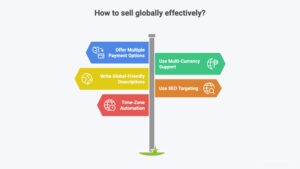
Legal & Setup Requirements
To run your business smoothly:
- Get a domain & hosting (for WordPress)
- Create privacy policy, refund, and terms pages
- Register a PayPal Business account
- Use SSL certificate to secure your website
If in India, you can use a GST number once sales scale up
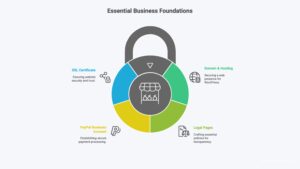
Scaling Your Business
Once your first product sells, don’t stop. Create an ecosystem:
- Bundle related products (eBook + course + checklist)
- Offer subscription-based access
- Create affiliate programs for other creators to promote your items
- Repurpose your content (turn blog posts into eBooks or courses)
The real growth happens when you start building a brand around your niche.
Final Thoughts
Selling digital products online is one of the smartest ways to build a global, low-cost, and scalable business in 2025. With the right setup, you can turn your skills, knowledge, or creativity into consistent income.
The key is to start small, even one simple eBook, template, or course can begin your journey. Focus on providing value, automate your systems, and let the internet do the rest.
You’re not just selling files, you’re selling solutions, creativity, and time-savers that people genuinely need.
So open that laptop, start building your first product, and watch your ideas go global.
Quick Summary
| Step | Action | Tools |
|---|---|---|
| 1 | Choose a profitable niche | Etsy, Gumroad, Creative Market |
| 2 | Create digital product | Canva, ChatGPT, Notion |
| 3 | Set up store | WordPress + WooCommerce, Payhip |
| 4 | Integrate payments | PayPal, Stripe, Razorpay |
| 5 | Automate delivery | SendOwl, Gumroad |
| 6 | Market globally | SEO, YouTube, Email marketing |